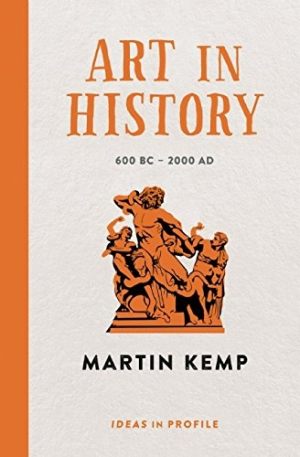Art in History, 600 BC–2000 AD
An engaging, at times playful, overview of the major art movements through history, all placed in historical context.
Martin Kemp, emeritus professor of the history of art at Oxford, as well as an expert on da Vinci, has several published books to his credit on the history of art. Part of the Ideas in Profile series, Art In History stands apart in considering art chronologically, with individual artists, movements, and pieces placed in their larger historical context, Kemp also engages considerations of economic and material influence on the artist, and even the art viewer as well. Overwhelmingly, though, the book is a historical look at art, and often shows the historical influences and events that shaped the art of the times. The book offers an overview to the major art movements through history, offering just enough detail to give a general understanding, and to perhaps inspire further reflection on movements or painters that interest the reader.
Kemp also engages theoretical underpinnings, and will occasionally ground an explanation in what a thinker or artist defined art as, and the cumulative shifts in the various definitions of art throughout the course of the book itself offer a fascinating narrative. For example, when discussing the Roman view of art, Kemp says, “Art, for Pliny, arose from the imposition of high culture on physical materials—paint, bronze, marble and so on—involving supreme individual talent (ingenium or ‘genius’), the imitation of nature, the distillation of beauty, the imaging of the divine, and the conveying of emotion in narratives.”
Toward the end of the book, as the movements come in more rapid fire than for earlier periods, and as the movements themselves become more playful (Dada, surrealism, postmodernism), Kemp’s style grows more lighthearted and conversational as he whips through the movements, highlighting one or two representative painters at a time. Black-and-white images and two-color printing enhance visual interest with stylized illustrations illuminating some of Kemp’s key points, some of which are comics, adding a note of humor. The book would be a fine introduction to a reader who has some interest in art but wants a more general overview and historical context, and the engaging style and design will appeal to a range of ages.
Reviewed by
Natasha Gilmore
Disclosure: This article is not an endorsement, but a review. The publisher of this book provided free copies of the book to have their book reviewed by a professional reviewer. No fee was paid by the publisher for this review. Foreword Reviews only recommends books that we love. Foreword Magazine, Inc. is disclosing this in accordance with the Federal Trade Commission’s 16 CFR, Part 255.

